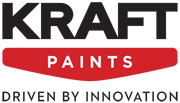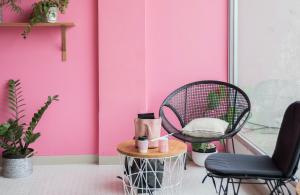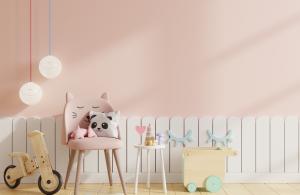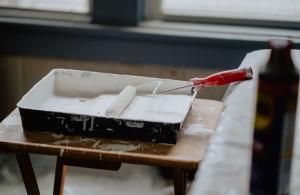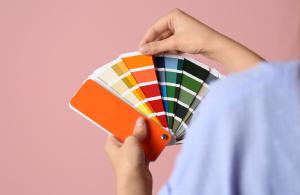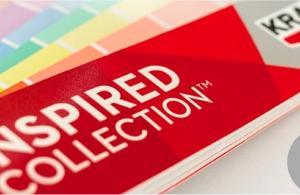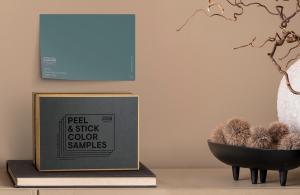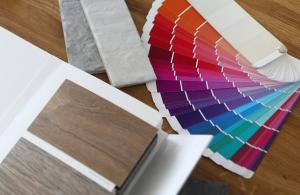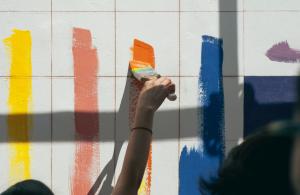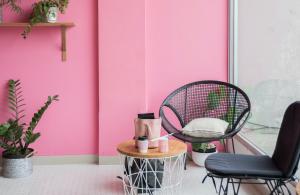Useful Advice
Interested in learning how to paint? First, look at the instructions on the back of the package, wear comfortable clothes & select the KRAFT Paints playlist on Spotify. Take a look at some additional tips.
Tools & Products
There are many types and sizes of brushes available on the market, and you may not be sure which is the right one. You should take into consideration 2 criteria: 1) the type of paint you will use, and 2) the surface you will be painting. If you're using acrylic paint, such as 4 seasons™, then choose a brush with natural bristle as it holds the paint better. If you're using an emulsion paint like MASTER, opt for a nylon or polyester paint brush.
On larger surfaces (skirting boards, doors, etc.), use a flat long bristle paint brush. On challenging surfaces (corners, radiators, etc.), prefer a long angled brush. For corners and textured details, use a round brush.
Good brushes have more bristles and create a smoother, more even surface and last much longer.
When deciding to paint one or more spaces, you will naturally enter the enjoyable process of choosing a color, but equally important is the selection of the right type of product. There are numerous types of paint available on the market that are differentiated by their properties. You will need to decide according to your specific needs.
More specifically, today you can find paints with
- Hypoallergenic properties
- Ecological composition
- Antifungal properties
- Antimicrobial composition
- Low cost
- Great coverage
- Resistance to washing
- Composition that contributes to a healthy atmosphere and more.
So, if for example you want to paint a generally dark and humid space, it is better to choose a paint such as MASTER HYDROCONTROL or GO! HYDROCHROMA, which prevents moisture accumulation on surfaces.
Moreover, for a children's room that often requires frequent cleaning and where you would like a hygienic paint, the ideal choice is something like MASTER EASY CLEAN, which contributes to a healthier indoor environment with very low VOCs emissions and is also easy to wash.
If this is the first time you're going to paint the house yourself, the first thing you should do is make a list of everything you'll need:
- Roller with medium length nap
- Extension pole (to attach to the roller if you're painting the ceiling as well)
- Paintbrushes
- Flat brush with long hair bristles for large surfaces (walls, doors, etc.)
- Brush with a long handle and angled head for hard to reach areas (corners, nooks, crannies etc.)
- Round brush for corners and detail work
- Masking tape (thin and wide) to cover areas that won't be painted
- Putty knife
- Stirring stick
- Paint tray suitable for the size of your roller, into which you will pour the paint and roll the roller to evenly distribute the paint
- Sponge (for surface cleaning)
- Sandpaper (No. 120-150)
- Nylon or cardboard or ondule paper to cover the floor
Technical Solutions – Color
Sometimes we notice exterior color peeling. This can happen in specific areas outside rooms with high humidity, such as the bathroom. In this case, you should repair it immediately, not only for aesthetic reasons but mainly because moisture can lead to mold formation on the wall, especially during winter. First, remove any loose residues of the previous paint, sand it down, and fill it with SPACHTEL. Prime the wall with ECO DUR AQUA for strong adhesion and protection, and finish with 2 coats of 4 SEASONS for excellent weather resistance and improved wall breathability.
A. Quantity
Once you have chosen your color, you need to calculate the quantity you will need. Refer to the paint calculator of Kraft Paints here.
Remember: Round up in your estimation. It is better to have some paint left over than to run out.
B. Cost
Costs vary depending on the quality of the product you choose. However, keep in mind that in the long run, it is more beneficial to opt for good quality, as this will ensure greater durability. Also, take into account the cost of tools and other supplies (rollers, tray liners, brushes, masking tapes, etc.).
C. Time
For the total time required, allocate some time initially for preparing the space (removing/covering furniture, protecting the floor, masking tape over outlets and light switches, baseboards, etc.). Thereafter, you should keep in mind that before applying the second coat, the first coat should be completely dry—ideally, start the next day. For an average-sized apartment (50-100 sq.m.), one weekend is usually enough!
Whether you want to freshen up a space or completely change the colors on the walls, you need to follow some specific steps for a perfect result:
A. Clean the walls thoroughly with soap and water.
B. Smooth out any bumps and imperfections of the wall with sandpaper and patch any holes with SPACHTEL. Finally, get rid of the dust.
C. If you have used putty in various spots, apply the DUR AQUA WHITE waterborne primer. If the surface was previously painted with emulsion paint or glue, use ECO DUR AQUA. If many years have passed since the last painting or if there are wall stains, apply the ECO STAIN BLOCKER AQUA primer. This primer isolates old stains, preventing them from migrating into the topcoat, while also reducing the amount of paint you will need.
D. Apply masking tape to areas you do not want to paint.
E. Start by painting the corners with a triangular brush.
F. Apply paint to the entire wall with a roller, following the 'W' motion. You can choose an affordable emulsion paint like PROFI INTERIOR, which can be tinted in thousands of shades.
G. Allow the paint to dry thoroughly and apply the second coat.
Ready!
In most brick constructions, bricks are normally used as they are, while their color variations are more or less limited. If you want to create an original and impressive effect by painting brick surfaces, you need to take into account some factors beforehand.
Brick is a building material that allows the building to breathe, so it is advisable to choose colors that will not "block" it and that are suitable for porous and alkaline surfaces. Firstly, prepare the surface by removing any moisture or mold and repairing any cracks. The surface should be completely dry before application. Then, apply a coat of DUR AQUA WHITE primer for strong adhesion, followed by two coats of 4 SEASONS, which ensures breathability, protection, and a perfect finish on the brick.
Regarding shades, avoid lighter ones as they tend to isolate dust on the brick. Go for darker shades, such as a bright gray like November Rain KR2697 or a green like Hollyhock Garden KR1537, to obtain a uniform surface.
To calculate the amount of paint you will need, you should first measure the surfaces you are going to paint.
For the interior of the house:
- In each room you are going to paint, measure floor area and the height of the walls. Then calculate the perimeter and multiply it by the height.
- Calculate the area of each opening (doors, windows) and subtract these measurements from the previous result.
- If the openings have reliefs or recesses (sills, alcoves, etc.), calculate these areas as well and add them to the above calculation.
- Repeat this process for all rooms and finally add up the measurements.
- If you are going to paint the ceiling as well, assume that it has an area equal to that of the floor. If it has a slope, take it into account in the calculation.
For the exterior of the house:
- Multiply the height of the building by the length of each side and add up the areas.
- Calculate the surfaces of the openings and subtract them from the total area. Add the areas of possible recesses and niches.
- Once you have calculated the final square meters, check the packaging of the paint you have chosen for the specific coverage indication (m2/lt), which indicates approximately how many square meters can be painted with one liter of the product for one coat. Divide your final square meters by this value, then multiply the result by 2 to find the liters you will need for 2 coats.
For more convenience, refer to the KRAFT Paints paint calculator, here.
Note: The actual amount of paint you will ultimately need depends on other factors such as the foundation, the thickness of the reliefs, the absorbency of the surface, painting conditions, application method, etc.
Cleaning the exterior walls before painting will improve the lifespan of the paint. In addition to hoses, buckets, etc., high-pressure cleaners will be particularly useful.
- Start by washing from top to bottom with plain water to remove dirt, spiderwebs, leaves, etc.
- Once the surfaces have dried, add detergent to the device and wash from bottom to top. Let it soak for 10 minutes and rinse from top to bottom with plain water. (Caution: Do not use chlorine or chlorine-based products).
- Allow to dry completely (at least 48 hours) before proceeding with the painting.
First, gather all the tools and materials you will need:
- Soap and water
- Sandpaper
- Primer
- Eco-friendly acrylic enamel paint (e.g., WOOD AQUA)
- Roller
- Paint tray
- Brushes
Clean the surface thoroughly with soap and water, and when it is dry, sand it with sandpaper and wipe off the dust with a damp cloth. Then, apply a stain-blocking primer, such as VELATOURA AQUA. Allow it to dry for at least 24 hours. Proceed with the paint application and apply the second coat after the first one has dried well. A good choice is the WOOD AQUA polyurethane acrylic enamel paint, which comes in 11 different shades, offering durability and easy cleaning.
On new unpainted surfaces: Start by applying the wood preservative WOOD CARE AQUA. Then, apply VELATOURA AQUA to fill in any imperfections in the wood, and finally, use WOOD AQUA.
On window and door frames, in addition to the above steps, fill any gaps with silicone and prime with the eco-friendly insulating ECO STAIN BLOCKER AQUA primer to prevent future cracks and adhesion issues.
First, fill the surface with SPACHTEL putty, and then apply either the ECO DUR AQUA primer or the DUR AQUA WHITE adhesion filling primer. Proceed to painting by applying two coats of your chosen color. Prefer a high-quality product such as the MASTER family paints.
First, fill the joints of the plasterboard with the elastomeric acrylic PUTTY, and then with SPACHTEL. Next, prime it with DUR AQUA WHITE, and finally, apply the last coat (we recommend the MASTER collection).
If the surface is new or previously painted with water-based paint or glue, first use the ECO DUR AQUA or DUR AQUA WHITE primer. Then, apply a paint specialized for bathrooms and kitchens, such as MASTER HYDROCONTROL or ASEPSIS, which protect against mold, fungi, and bacteria.
If you want to paint tiles or marble, first apply the anticorrosive primer RUST BLOCKER AQUA for proper adhesion of the topcoat, and fill the joints with SPACHTEL.
If mold appears, you should first remove it with the special MOLD BLOCKER cleaner, and then apply the ECO STAIN BLOCKER AQUA insulating undercoat .
The ceiling is a surface that you may not always consider when painting, but painting it can transform the entire space!
Depending on the particular characteristics of the room, you can create the right illusion that will further enhance your space by choosing the appropriate color for the ceiling - always in thoughtful harmony or contrast with the colors of the walls and floor.
For example, if you want to make your space look "bigger", choose the same light shade for all the walls and the ceiling, while if you want to "shrink" a large room, do exactly the same but with a darker shade.
If the space has low ceilings and you want to make it appear taller, apply a darker shade to the walls and a light one (a bright white) to the ceiling. Conversely, if you want to make a room with high ceilings feel cozy, apply a light color to the walls and a dark or bright color to the ceiling.
HOW TO PAINT:
Fill in any gaps where necessary with SPACHTEL. If the surface is new or previously painted with emulsion paint or glue, use the ECO DUR AQUA primer or DUR AQUA WHITE. Then apply a high-quality, long-lasting paint from the MASTER family. Use a roller with an extension pole and apply the second coat in a criss-cross pattern.
Apart from the color you choose, the finish of each product also plays a significant role in the final result, determining how glossy the color will appear. The two main distinct choices for finishes are mat and glossy.
A mat finish has the ability to hide imperfections, as it does not reflect light. It is, therefore, preferable for ceilings that usually have more flaws, as well as for living room, dining room, and bedroom walls. Generally, mat colors are more difficult to clean, although this does not apply to high-quality mat paints, such as those from the MASTER family. You can also choose more specialized products, such as MASTER HYDROCONTROL with an ultra-mat finish, which is especially suitable for bathrooms and kitchens as it resists moisture and prevents mold growth on its surface.
In contrast, a glossy finish tends to reveal surface imperfections as it reflects even the softest light. For this reason, it is not often preferred for walls, except as a complement for an artistic effect. It is more common on wooden surfaces or perfectly smooth surfaces, creating a very modern and luxurious feel. It looks great in bold color shades like red, cypress green, or vibrant blue. Additionally, it is the most durable finish and the easiest to clean.
For the exterior walls of your house, choose shades specially designed for outdoor surfaces, such as the shades marked with the ‘F’ symbol from the KRAFT INSPIRED COLLECTION or the shades from the KRAFT REFLECTIVE COLLECTION. The latter have been created to reflect much of the solar radiation, reducing the temperature of the exterior walls, improving energy consumption, and upgrading the comfort inside the house. The TSR (Total Solar Reflectance) value for each individual shade has been measured by the National Technical University of Athens, according to internationally certified measurement standards.
Technical Solutions - Renovation
Choosing a flexible tile adhesive with high adhesion and resistance to moisture and thermal expansion is key to long-term stability—such as FixoTile Flex 30.
Before tiling, it’s essential to apply a cementitious waterproofing layer to protect the substrate from water and moisture, such as Hydroguard One.
Without the right primer, the coating won’t bond properly to the surface. For ideal adhesion, use Arterra Patiti Nano-Hybrid Primer or Arterra Patiti Quartz Primer.
Absolutely—by applying the Hydroguard Elastic cementitious waterproofing system on the substrate, followed by tile installation with high-flexibility adhesives such as FixoTile Flex 30 or FixoTile GEL MAX.
Use a hybrid waterproof membrane that reflects solar radiation and remains elastic under various weather conditions—like Total Proof PU Hybrid.
You need a resin-modified repair mortar with mechanical strength to restore the surface—such as Strong Repair 84 or Fine Repair 83.
With a decorative cement coating that combines design and moisture resistance, like the Arterra Patiti series.
For new drywall or cement boards, fine leveling and joint coverage are needed. PowderFine Ready Mix is ideal, offering excellent workability, a smooth surface, and strong adhesion—perfect for any paint system.
For worn walls with cracks, blisters, or uneven surfaces, use a strong repair render. The fast-setting, fiber-reinforced render Fast Repair 70 fills defects and reshapes the surface, making it ready for filling and long-lasting painting.
For covering flaws, damage, or cracks at thicknesses of 2–20mm (up to 40mm locally), the multi-purpose smoothing repair compound Powderfine Multi (3-in-1) is an ideal technical solution. It reduces the need for multiple layers of different materials, addressing repair needs for renderings, damage to corners, holes, flattened cracks, joints, and both wall and ceiling surfaces—also functioning as a smoothing filler.
Ecological Awareness
Today, among other things, eco-friendly paints are available on the market that leave a light ecological footprint. KRAFT Paints offers many products that contribute to a healthy environment, but as the most ecological choice, we recommend MASTER ECO. It is a high-quality ecological emulsion paint approved by ASAOS, user-friendly, and completely safe for every space in your house.
However, don't limit yourself to color selection alone! Start and complete the entire painting process in the most environmentally friendly way possible, and more specifically:
- Use the paint calculator before purchasing the paint to avoid excess product.
- If there is leftover paint, store it according to the packaging instructions and turn it upside down to decrease air permeability.
- Dispose of residues in a safe and responsible manner.
- Recycle wherever possible.
